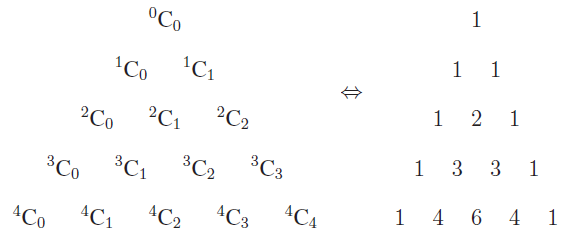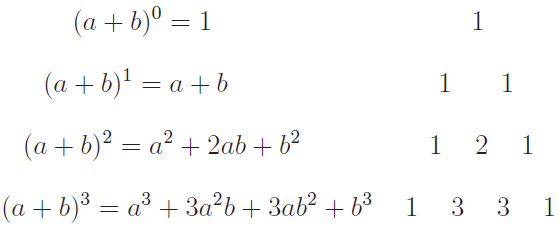BINOMIAL THEOREM
Binomial theorem facilitates the algebraic expansion of the binomial (a + b) for a positive integral exponent n. Binomial theorem is used in all branches of Mathematics and also in other Sciences. Using the theorem, for example one can easily find the coefficient of x20 in the expansion of (2x - 7)23.
If one wants to know the maturity amount after 10 years on a sum of money deposited in a bank at the rate of 8% compound interest per year or to know the size of population of our country after 15 years if the annual growth rate and present population size are known,
Binomial theorem helps us in finding the above quantities. The coefficients that appear in the binomial expansion of (a + b)n, n ∈ N, are called binomial coefficients. Binomial theorem plays a vital role in determining the probabilities of events when the random experiment involves finite sample space and each outcome is either success or failure
Binomial Theorem
The binomial theorem states the principle for expanding the binomial (x + y)n and expresses it as a sum of the terms involving individual exponents of variables x and y. Each term in a binomial expansion is associated with a numeric value which is called coefficient.
Pascal Triangle
The Pascal triangle is an arrangement of the values of nCr in a triangular form. The (k + 1)st row consists values of
kC0, kC1, kC2, kC3, ........kCk
In fact, the Pascal triangle is

Recall the expansion and observe the coefficients of each term of the identities
(a + b)0, (a + b)1, (a + b)2, (a + b)3
There is a pattern in the arrangements of coefficients.

If we observe carefully the Pascal triangle, we may notice that each row starts and ends with 1 and other entries are the sum of the two numbers just above it. For example ‘3’ is the sum of 1 and 2 above it; ‘10’ is the sum of 4 and 6 above it. We will prove in a short while that
(x + y)n = nC0xn + nC1xn-1y1 + nC2xn-2y2 + nC3xn-3y3............. ...................+ nCrxn-ryr + ........ nCnyn
which is the binomial expansion of (a + b)n. The binomial expansion of (a + b)n for any n ∈ N can be written using Pascal triangle. For example, from the fifth row we can write down the expansion of (a + b)4 and from the sixth row we can write down the expansion of (a + b)5 and so on.
We know the terms (without coefficients) of (a + b)5 are
a5, a4b, a3b2, a2b3, ab4, b5
and the sixth row of the Pascal triangle is
1 5 1 0 1 0 5 1
Using these two we can write
(a + b)5 = a5 + a4b + a3b2 + a2b3 + ab4 + b5
The Pascal triangle can be constructed using additional one, without using any multiplication or division. So without multiplication we can write down the binomial expansion for (a + b)n for any n ∈ N. The above pattern resembling a triangle, is credited in the name of the seventeenth century French Mathematician Blaise Pascal, who studied mathematical properties of this structure and used this concept effectively in Probability Theory.
Binomial Theorem for Positive Integral Index
If x and y are real numbers and n is a positive integer, then
(x + y)n = nC0xn + nC1xn-1y1 + nC2xn-2y2 + nC3xn-3y3............. ...................+ nCrxn-ryr + ........ nCnyn
where nCr = n!/[(n - r)!r!] for 0 ≤ r ≤ n.
The general term or (r + 1)th term in the expansion is given by
Tr + 1 = nCrxn-ryr
We have already learnt how to multiply a binomial by itself. Finding squares and cubes of a binomial by actual multiplication is not difficult.
But the process of finding the expansion of binomials with higher powers such as (x + a)10, (x + a)17, (x + a)25 etc becomes more difficult. Hence we look for a general formula which will help us in finding the expansion of binomials with higher powers. We know that
(x + a)1 = x + a = 1C0x1a0+ 1C1x0a1
(x + a)2 = x2 + 2ax + a2
= 2C0x2a0 + 2C1x1a1 + 2C2x0a2
(x + a)3 = x3 + 3x2a + 3xa2 + a3
= 3C0x3a0 + 3C1x2a1 + 3C2x1a2 + 3C3x0a3
(x + a)4 = x4 + 4x3 + 6x2a2 + 4xa3 + a4
= 4C0x4a0 + 4C1x3a1 + 4C2x2a2 + 4C3x1a1 + 4C4x0a4
For n = 1, 2, 3, 4 the expansion of (x + a)n has been expressed in a very systematic manner in terms of combinatorial coefficients. The above expressions suggest the conjecture that (x + a)n should be expressible in the form,
(x + a)n
= nC0xna0 + nC1xn - 1a1 + nC2xn - 2a2 + ….......
+ nCn-1 x1an-1 + nCn x0an
Remarks in Binomial Theorem
1. In the above expansion the power of x will get reduced and power of a will get increased. the general term is
nCrxn-rar
Since this is nothing but the (r + 1)th term, it is denoted by Tr+1
Tr + 1 = nCrxn-rar
2. The (n + 1)th term is Tn+1 = nCnxn-nan = nCnan, the last term.
Thus there are (n + 1) terms in the expansion of (x + a)n
3. The degree of x in each term decreases while that of 'a' increases such that the sum of the powers in each term is equal to n. We can write
4. nC0, nC1, nC2, ......., nCr, ........, nCn are called binomial coefficients. They are also written as C0, C1 , C2, ....…, Cn.
5. From the relation nCr = nCn-r, we see that the coefficients of terms equidistant from the beginning and the end are equal.
Middle Term in Binomial Expansion
The number of terms in the expansion of (x + a)n depends upon the index n. The index is either even (or) odd.
Let us find the middle terms.
Case (i) : n is even
The number of terms in the expansion is (n + 1), which is odd. Hence, there is only one middle term and it is given by T(n/2) + 1
Case (ii) : n is odd
The number of terms in the expansion is (n + 1), which is even. Hence, there are two middle terms and they are given by T(n + 1)/2 and T(n + 3)/2
Kindly mail your feedback to v4formath@gmail.com
We always appreciate your feedback.
©All rights reserved. onlinemath4all.com
Recent Articles
-
Logarithmic Derivative Problems and Solutions
Apr 16, 25 09:25 PM
Logarithmic Derivative Problems and Solutions -
Digital SAT Math Problems and Solutions (Part - 145)
Apr 16, 25 12:35 PM
Digital SAT Math Problems and Solutions (Part - 145) -
Digital SAT Math Problems and Solutions (Part - 144)
Apr 14, 25 07:27 PM
Digital SAT Math Problems and Solutions (Part - 144)

